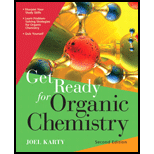
Concept explainers
(a)
Interpretation:
How the given transform would appear in a synthesis is to be shown.
Concept introduction:
A synthetic trap is a synthesis which prevents the reaction from occurring in the forward direction as planned. This occurs mainly because the reactant molecule contains multiple
In
(b)
Interpretation:
How the given transform would appear in a synthesis is to be shown.
Concept introduction:
A synthetic trap is a synthesis which prevents the reaction from occurring in the forward direction as planned. This occurs mainly because the reactant molecule contains multiple functional groups which interfere in the desired mechanism. However, even when there is only one functional group, a synthetic trap can still arise if a reaction takes place at two or more sites within that functional group. In such cases, regiochemistry is an issue. Regiochemistry is the specific region in the given molecule at which the reaction takes place selectively. We can choose a synthesis according to the regioselectivities of the functional group transformation reactions.
In epoxide ring opening reactions, the regiochemistry can be controlled using acidic or basic/neutral medium. The nucleophile tends to attack the most substituted carbon atom under acidic conditions whereas a nucleophile tends to attack the least substituted carbon atom under neutral or basic conditions.
Trending nowThis is a popular solution!

Chapter 13 Solutions
Get Ready for Organic Chemistry
- (SYN) For each of these compounds, draw an alkyl (a) (b) halide that can be used to produce it in an E1 reaction. Then, draw the E1 mechanism that would take place when the alkyl halide is treated with water.arrow_forwardBonus Question: If you deemed the previous reaction to be unsuccessfull, propose a reaction or synthesis that would successfully produce the desired ether product (shown again to the side). You may use any reaction you know of.arrow_forwardPlease explain in detail, thank you!arrow_forward
- (SYN) Show how to carry out this transformation using any reagents necessaryarrow_forwardDraw the complete, detailed mechanism for the reaction shown here and give the major product. CH3I (excess) ? NH2arrow_forwardThe crossed aldol reaction shown here can be carried out using a weak base such as pyridine. (a) Draw the complete, detailed mechanism for this reaction. (b) Explain why a relatively weak base can be used. EtO OEt H EtO OEt H. Diethyl malonatearrow_forward
- Draw the complete, detailed mechanism for the reaction shown here and predict the major product. CH3ONA Explain. DMSOarrow_forwardOne way to synthesize diethyl ether is to heat ethanol in the presence of a strong acid, as shown here. Draw a complete, detailed mechanism for this reaction.arrow_forwardDraw the complete, detailed mechanism for the following reaction, and predict the major product. NaCI MeOHarrow_forward
- Draw the complete, detailed mechanism for the following reaction.arrow_forwardThe reaction shown here is an example of the Favorskii reaction, which involves an R¯ leaving group in a nucleophilic addition-elimination reaction. (a) Draw the complete, detailed mechanism for this reaction and explain why R can act as a leaving NaOH H2O group. (b) Suggest how you can synthesize an ester from cyclopropanone using only this reaction.arrow_forwardDraw the complete, detailed mechanism for the reaction shown here. Will the product be optically active? Explain.arrow_forward
 Organic Chemistry: A Guided InquiryChemistryISBN:9780618974122Author:Andrei StraumanisPublisher:Cengage Learning
Organic Chemistry: A Guided InquiryChemistryISBN:9780618974122Author:Andrei StraumanisPublisher:Cengage Learning
